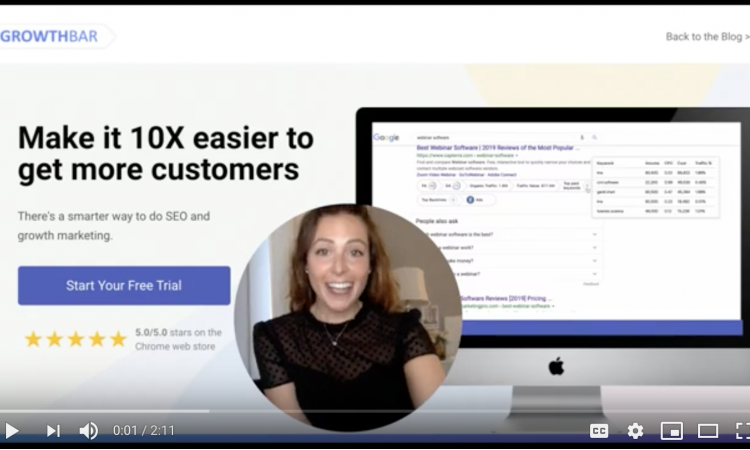Google doesn’t publicly reveal the “secret ingredient” that powers its search algorithm, and the company is constantly making tweaks and adjustments to continually make results cleaner and more effective. But despite all of this mystery and complexity, it’s still possible to improve your website’s performance with a few relatively simple steps.
According to Kevin Miller, co-founder and CEO of Los Angeles-based digital marketing agency GR0, making a big positive impact on these rankings can be as simple as setting up profiles on major social media sites and web directories. “Platforms like Glassdoor, BuiltIn, and Clutch, to name a few, have incredibly strong domain rankings that allow these profiles to rank high in Google searches,” Miller explained. “If your profile is constructed correctly, most companies have a very good chance of ranking on the first page of your brand name. This allows a brand to dominate the SERPs (Search Engine Results Pages) from page 1 within a short period of time.”
GR0 offers a customized B2B service with only one mission: to help brands rank #1 on Google. GR seeks to demystify the SEO process for its clients so they can reach their full potential and deliver unmatched value to each client. Now, in collaboration with dot.LA/The Founders Guide, they’re sharing for the first time his secret sauce: 7 tips to help your brand conquer SEO.
STEP 1: GETTING STARTED / BASIC TIPS
Contents
- 1 STEP 1: GETTING STARTED / BASIC TIPS
- 2 STEP 2: GLASSDOOR
- 3 STEP 3: GOOGLE MY BUSINESS PAGE
- 4 STEP 4: CRUNCHBASE
- 5 STEP 5: BUILT-IN LA
- 6 STEP 6: COMPARABLY
- 7 STEP 7: CLUTCH
- 8 STEP 8: SOCIAL MEDIA
- 9 What are the most important parts of SEO?
- 10 What is SEO and its components?
- 11 Is SEO a dying industry?
- 12 What is the importance of SEO?

The first and most important step of all comes at the top: Make a list of the keywords and phrases in addition to your brand name that you want to stand out the most in Google results. Remember that the most popular and most searched words and phrases are extremely competitive, so it is wise to select some secondary or tertiary keywords as well. (Instead of trying to rank for the term “dentist,” try “West Philadelphia dentist,” or “Painless West Philadelphia dentist,” or “Painless, inexpensive West Philadelphia dentist,” for example.)
You will include these keywords in every article you post about your product, business, or service on other sites, so they should be relevant and natural to you for you to incorporate into sentences.
STEP 2: GLASSDOOR

Glassdoor is a large and very established service that allows tech workers to rate and review their employers.
As with Comparably, having an “Employer Profile” on Glassdoor offers a number of benefits. This way, you take control of the conversation and present your company and brand in the most positive and effective way that gives potential employees a clearer idea of what it’s like to work for you.
STEP 3: GOOGLE MY BUSINESS PAGE

My Business Pages are a free tool from Google to help businesses manage their online presence. This is an especially important tool for local businesses looking to achieve a larger presence in their immediate region or core business, as Google organizes search results based on your location during searches. This means that a business with a clearly labeled location will perform better when searched by people in that area.
Google uses the data from the My Business pages to power its “Knowledge Graph,” a key component in how the algorithm structures and organizes information. Also, Google creates a Maps location for each My Business listing, so your business will now appear in Google Maps searches and searches on any third-party platform using the Google Maps API.
STEP 4: CRUNCHBASE

Crunchbase collects basic information about startups and industry trends, as well as profiles individual companies. Because it’s a longstanding and trusted resource that also allows business owners to customize and flesh out their profiles, it’s also a powerful SEO tool.
When filling out your Crunchbase profile, specifics are always better than vague generalities or “marketing language”. Also avoid phrases like “my company” or “our company”. Whenever you can, add your brand name without sacrificing readability.
Fill out the complete profile without skipping important steps. “Date Founded” is a popular search among Crunchbase users, so make sure you’ve filled that in too. Also keep in mind that investors primarily use Crunchbase to research funding. So the more thorough you can be in these sections – including links to articles about your previous rounds if available – the better. Also, be sure to update your Crunchbase file whenever there is important news about your business.
STEP 5: BUILT-IN LA
This community for startups, tech companies, and their employees has a local element: in addition to Los Angeles, there are Built-In locations for Austin, Boston, Chicago, Colorado, New York, San Francisco, Seattle, and more. The site is largely geared towards employee satisfaction and recruitment, but it’s also another quality link that leads back to your company, increasing your visibility with people scanning LA tech startups in general.
STEP 6: COMPARABLY
Comparably is a community tool that allows employees to securely and anonymously review and discuss their employers. For employers, alongside the SEO benefits of setting up a Comparably profile, a cheap Comparably page with fair and accurate employee reviews can be a great way to attract additional talent.
Because Comparably is well established in its industry and features original editorial content that keeps the site active and relevant, its pages rank high on Google for dozens of search terms related to jobs and job search. This not only helps with recruitment but also with media exposure; These profiles are a great way to share publicly available employee benefits and programs, such as B. Strengthen diversity and inclusion efforts.
STEP 7: CLUTCH
Clutch.co is also based on ratings and reviews, but from a B2B perspective rather than an employee and employer perspective. The Clutch platform provides in-depth reviews of companies offering B2B services based on analysis and feedback from past clients to see how companies and their services are performing in specific markets. These profiles have the same benefits as the employee-centric services, but exclusively for companies that want to attract the attention of other managers, founders, and startups in the B2B space.
While the previous steps were based on setting up one-time profiles, some of which may require occasional updates, it’s also important for your business to regularly post fresh content on major social media sites like Twitter, LinkedIn, and Facebook.
Social media posts don’t directly contribute to your SEO ranking, but links shared through these platforms increase your business’ exposure and can ultimately help improve your ranking in a number of ways. Studies have consistently found a connection between social shares and SEO rankings for individual links.
It’s good practice to tweet at least once or twice a day and then post the same content to your company’s LinkedIn and Facebook profiles.
What are the most important parts of SEO?
- Keywords. Keyword research is the first step to a successful SEO strategy. …
- meta tags. Meta tags still play an important role in SEO. …
- Contents. It’s true, content is king. …
- backlinks. If content is king, then backlinks are queen. …
- social media. Algorithms have really changed since the advent of social media. …
- product images.
What are the 3 main components of SEO? There are three types of SEO you need for a well-rounded organic search strategy: on-page SEO, technical SEO, and off-page SEO. By breaking down your strategy and looking at SEO as these three categories, it becomes much easier to organize and execute your optimization plans.
What is SEO and its components?
SEO stands for “Search Engine Optimization”. Simply put, SEO helps increase your online visibility through search engines like Google or Bing when potential customers search for keywords related to your business. The better your SEO, the more visible you become, which increases your potential for customer visits.
What is SEO and its types? The three types of SEO are: On-Page SEO – Everything on your web pages – blogs, product copy, web copy. Off-page SEO – Anything that happens outside of your website that helps with your SEO strategy – backlinks. Technical SEO – Anything technically done to improve search ranking – Website indexing to help bot crawling.
What are the 3 components of SEO?
We’ve covered the three basic parts of SEO: Technical SEO, Content/Relevance SEO, and Promotional/Authority SEO.
What are the 3 C’s of SEO?
Simply put, the basics of SEO boil down to the 3 Cs: content, code, and credibility.
Is SEO a dying industry?
Make no mistake: SEO isn’t dying, but it’s evolving into much more than it did years ago. If you’ve been debating whether or not to invest in SEO for your business, read on to learn why SEO isn’t dying in 2021 — it’s actually thriving.
Is SEO relevant in 2021? Organic search usage and share is outpacing growth in other channels. Organic and paid web traffic dominated in 2019. Performing SEO for Google and other search engines will become even more important in 2021 as organic search continues to outpace other search traffic.
Is SEO still relevant in 2020?
While some traditional marketing methods may be obsolete, SEO is here to stay in 2020. Whether you invested in SEO early on or are just starting out, it can still be a major driver of traffic and leads to your website.
Is SEO still relevant in 2022?
Will SEO still be relevant in 2022? Yes of course. Although some SEO tactics that were effective in the past no longer work, SEO has continued to evolve. Constantly reinvents itself to try to better serve users’ intentions, cutting out the spammy, ineffective tactics to get better.
Why does SEO still matter in 2021?
SEO remains relevant in 2021 and savvy marketers should find ways to leverage content marketing alongside other exciting traffic channels like social media management. SEO is a form of inbound marketing that expands your brand’s reach by targeting long-tail keywords.
Is SEO still worth it in 2021?
The short answer is: SEO is very effective – not only for generating traffic, but also for leads and sales. Don’t worry. The long answer includes research and data, not just empty claims. Most SEOs get too caught up in search-specific metrics like SERPs (search engine results page), rankings, and organic traffic.
Is SEO dead in 2022?
no SEO is not dead in 2022. SEO is still a very powerful digital marketing strategy. SEO will continue to change as Google updates its algorithm, but that’s to be expected.
Comment être référencée sur Google ?
«Etre bien place dans les résultats de Google, cela passe par un bon usage des mots-clés, de leur coherence avec le content de chacune des Seiten.» Your site should be structured, secured and quickly available on the website, notamment on a smartphone.
Comment utiliser la Search Console de Google ?
Visit the Google Search Console (formerly Google Webmaster Tools) page to register your website. Sur l’écran qui s’affiche, on vous demande de tester que le site vous appartient. Pour cela, cliquez sur “ajouter une propriété” et indiquez le prefixe de l’URL de your site or le domaine.
What is the importance of SEO?
SEO stands for search engine optimization. Simply put, good SEO optimizes your online visibility. This means that the more people see your website, the more your online traffic will increase and the better your chances of offering your product or service to a larger number of people.
How is enterprise SEO different? The biggest difference between SEO for business websites and “normal” websites is scope. It’s one thing to optimize a few pages on a small website. But when you’re dealing with a website that has thousands of pages, you need to scale everything you do.
What is an enterprise SEO platform?
Enterprise SEO is a comprehensive, comprehensive approach to search engine optimization for large companies that manage websites with thousands of pages and need robust SEO strategies. Corporate SEO marketing is an area that requires both high-level and granular-level strategies to increase sales for large organizations.
Is SEO a digital platform?
SEO platforms. An SEO platform offers a holistic solution for a range of digital marketing and organic search needs through integrated technology to optimize workflows, productivity, user management and advanced reporting capabilities.
What platform do you use for SEO?
1. Ahrefs: SEO Keyword Tool. Ahrefs is one of the most recommended SEO tools on the web. It is only the second largest website crawler after Google.
Who is Botify?
Most businesses live or die in Google search rankings. If you can’t crack the first few results, it’s almost impossible to consistently drive organic traffic to your website.
How much does Botify cost?
Botify costs between $569 and $999 per month. With already 300 customers, the startup has a healthy business model.
When was Botify founded?
Founded in 2012, Botify has built the interface and methodology that connects the largest, most complex websites to all major search engines to drive more traffic and revenue from organic search.
Where is Botify located?
Botify is headquartered in New York, NY and has 8 office locations in 6 countries.



